|
QEMM5060 QEMM 50-60 for memory expansion adapters
1-8MB 286 Memory Expansion Adapter (30-pin)
2-8MB Memory Expansion Adapter (72-pin)
Factory Upgraded 2-8MB Memory Expansion Adapter
2-8MB 386 Memory Expansion Adapter (72-pin)
2-14MB Enh 386 Mem Expansion Adapter (FDDE, FDDF)
Identifying FDDF Old, New, and FDDE
Compatible 72-pin SIMMs
BOPT103.EXE - Upgrade SC.EXE and ADF/ROM
Functions of BOPT
Updated SC.EXE, Initializers, Active ROM
512KB/2MB 286 Memory Expansion Adapter 72X8532 / 90X8167 / 90X8799
![Front [P]](/other/img/photo.gif)
![Back [P]](/other/img/photo.gif)
@FEFE.ADF is built into the relevant reference disks
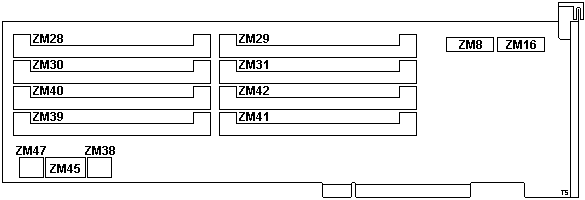
ZM8,16 1Kx4 SRAM
ZM28-31,39-42 30-pin SIMM socket
ZM38 Pulse PE-21911 150 ns delay line
|
ZM45 Pulse PE-21783 100 ns delay line
ZM47 Pulse PE-21901 25 ns delay line
|
ZM8,16
Am2149-35DC,
CY7C149-35PC,
or compatible 1Kx4 SRAM
Discrete TTL logic and PAL/GALs only.
1-8MB 286 Memory Expansion Adapter 1497253 / 61X6752
![Front [P]](/other/img/photo.gif)
![Back [P]](/other/img/photo.gif) (photo by Ilya Vorobiev)
(photo by Ilya Vorobiev)
ROM Images (from David Beem)
11F8060.zip Copyright '86 [!] or '88
61X6724.zip Copyright '87
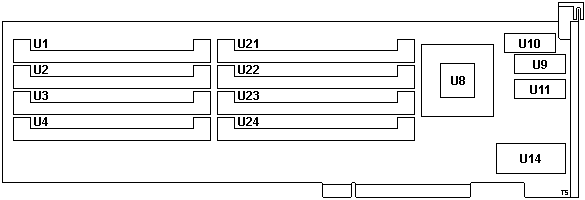
U1-4,21-24 30-pin SIMM socket
U8 LSI L1A3307 61X6715 DSGA
|
U9-11 CY7C168-25PC 4Kx4 SRAM
U14 BIOS EPROM
|
This adapter provides 1 MB of memory expansion with LIM EMS
Version 4.0 support for all PS/2 Models 50, 50Z, 55 SX, 60 and 65 SX.
Expanded Memory Adapter 0-8MB XMA
@F7FE.ADF "IBM Expanded Memory Adapter 0-8MB XMA"
@085.PEP

188-084 IBM Personal System/2 0-8MB Expanded Memory Adapter/A
The PS/2 1-8MB 286 Memory Expansion Option is functionally equivalent to
IBM's existing 2-8MB 80286 Memory Expansion Option (#8286, 6450609), but with
1 MB of standard 85 ns memory. It is expandable in increments of 1 MB or 2 MB
up to a maximum of 8 MB by using 1 MB SIMMs 85 ns or 2 MB SIMMs 85 ns.
"Optional 0-8MB Expanded Memory Adapter/A Cards (1497259, #7259) can be
added to enhance system memory. Each card may be expanded from 0 to 8 MB.
Multiple cards can provide a maximum of 16 MB of memory on the system, with one
wait state. Refer to Product Announcement 188-084, dated June 2, 1988, for
additional information."
2-8MB Memory Expansion Adapter
FRU P/N 15F8292, P/N 15F8289
![Front [P]](/other/img/photo.gif)
![Back [P]](/other/img/photo.gif) (Japanese design)
(Japanese design)
@F7F7.ADF IBM 2-8MB 286/386SX Memory Expansion Option
@194.PEP
ROM Images (from David Beem)
U1V2Prom.zip "STRPSTCD V2 EPROM"
57F2905.zip "V3 EPROM"
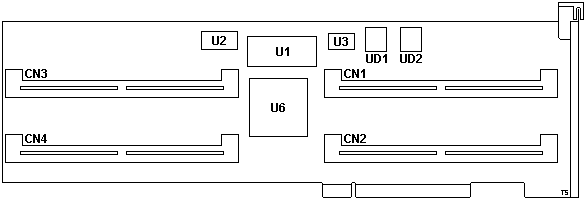
David Beem said:
The IBM "2-8[MB]" 16-bit memory card (P/N 15F8292) has four 72-pin
SIMM sockets & an EPROM (on the middle of the upper edge). If you have the
newer EPROM version (copyright 1991 AFAIR) you can populate all four sockets
with 2 MB 80 ns SIMMs for an additional 8 MB to the possible 55SX planar 8MM
(16MM, maximum on the 24-bit addressed 386SX).
For systems with 24 bit addressing and 8 MB on planar (like the 55SX), the
older EPROM version prompts about resizing memory with a non-fatal error
requiring a keypress to continue every boot. Once the error is acknowledged the
system is fine from there. In this case, it is better to populate the last SIMM
socket with a 1 MB 80 ns module (allowing 15 MB total system memory) in that
case (or find someone to burn an EPROM of the newer version). The card's RAM is
treated as being "Extended", same as the upper planar memory. I treat the newer
EPROM as mainly having (other differences haven't been studied) the "OK, OK,
just cut the memory to size & don't tell me about it" code.
Cheers reports the older EPROM version as "Copyright 1989 V2". The newer is
a double date of "1990, 1991" AFAIR & may have "V3". Never have seen the
original ("V1", if such thing were marked) in the wild out of a half-dozen
cards. The later version is on less than half the cards in that same (very)
rough sampling.
This card is excellent filling both the 55SX & 65SX (the only MCA
286/386SX systems able to use it & have 8 MB of planar memory maximum) to
capacity with Extended RAM. The 609 or other 16-bit MCA memory cards with
software could perhaps eclipse it by supporting more than 8 MB on the card (for
something like the 50/50Z/60 models) or being able to split itself for Extended
& Expanded memory.
19498 Errors With 2-8MB 80286 Memory Adapter H12398
Failing systems with the following:
- 2-8MB 80286 memory expansion adapter installed (FRU P/N 15F8292).
- Total of 16 MB installed in the system.
- System fails with a 19498-16xxx POST error.
Some 2-8MB memory expansion adapters may fail with a POST error of
19498-16xxx (xxx can be any number). This is a false error in systems with 16
MB total installed memory, and can be corrected by replacing the memory adapter
EPROM. PS/2 systems that support the 2-8MB 80286 memory expansion option should
not be configured with more than 16 MB total memory. If more than 16 MB is
installed, a 19498 POST error is valid and will not be corrected by EPROM
replacement.
If the system displays the 19498-16xxx error code, replace adapter EPROM
with FRU P/N 57F2905. In systems with two 2-8MB adapters installed, replace
the EPROM on both cards.
The 2 - 8MB adapter has only one EPROM socket, located along the top edge
of the card at location U1. A correctly installed EPROM will have its small
notch facing left, away from the bus connector.
Until the EPROM is replaced, a 19498 error may be bypassed with the F1 key,
leaving the system fully functional.
Factory Upgraded 2-8MB Memory Expansion FRU P/N 85F0480, P/N 10G3812
![Front [P]](/other/img/photo.gif)
![Back [P]](/other/img/photo.gif) | |
![Front [P]](/other/img/photo.gif)
![Back [P]](/other/img/photo.gif)
The 2-8MB Memory Expansion P/N 15F8292 was probably upgraded at factory
(the stickers are perfectly aligned) with the 57F2905 EPROM -AND- had a
sticker to cover the original FRU - P/N on the back. I expect if you carefully
peeled up the right hand sticker, you would see 15F8292.
I've not seen any references to adapter rework or defective components. It
appears the only difference between the 15F8292 and the later 85F0480 is the
57F2905 EPROM.
Comparison shots of the 85F0480 and 15F8292 adapters:
![Front [P]](/other/img/photo.gif)
![Back [P]](/other/img/photo.gif)
2-8MB 386 Memory Expansion Adapter 90X9556 or 90X9369
![Front [P]](/other/img/photo.gif)
![Back [P]](/other/img/photo.gif) (Japanese design)
(Japanese design)
@FCFF.ADF IBM 0-8MB 386 Memory Expansion Adapter
CFCFF.ADF Init file for @FCFF.ADF
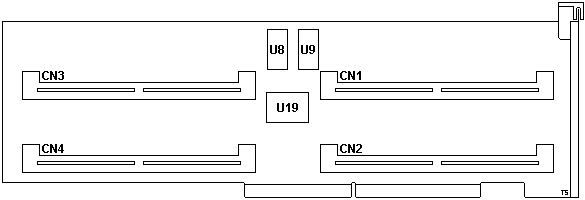
CN1-4 72-pin SIMM socket
U8 75 ns delay line
|
U9 150 ns delay line
U19 SLA7340F1A gate array
|
2 MB 85 ns SIMMs - FRU # 92F0104 (option number 6450604)
2-14MB Memory Expansion Adapter FDDF and FDDE
@FDDF.ADF Enhanced 80386 Memory Expansion Adapter
CFDDF.ADF Init file for @FDDE.ADF
FDDF 34F2825 Enhanced 80386 Memory Expansion Adapter (old 2-14)
- FRU P/N 87F9916 IBM PS/2 Enh. 80386 Memory Exp. Adapter (old, resistors added)
- IBM PS/2 Enhanced 80386 Memory Expansion Adapter (new) white socket
@FDDE.ADF Enhanced 80386 Memory Expansion Adapter w/ROM
CFDDE.ADF Init file for @FDDE.ADF
FDDE 88F0075 Enhanced 80386 Memory Expansion Option (FDDF plus 8K EEPROM)
Ed Avis confides to the world:
IIRC there were three variants of the 2-14 card:
- without ROM: this writes IADF code to the MBR of the boot device. Generally
a bit of a pain and won't work with Linux (though I have heard that it works
if you use the Minix bootloader to boot Linux). I already have one of those
cards.
- with ROM: this counts its memory at the same time as the planar memory
(like the 2-8 card does) and is easier to install. Apparently if you have one
'with ROM' card it can also take command of any 'without ROM' cards and let
them work without needing boot track code.
Apparently there are two variants of the 'with[out] ROM', I don't know if
there is any difference in use.
Supports 1 MB, 2 MB, and 4 MB 80 ns or 85 ns IBM memory.
Mandatory Replacement ENHANCED Enhanced 80386 Memory Expansion
ECA 042
Identifying the FDDE, FDDF (old) and FDDF (new) Adapters
All three share the same basic outline.
The FDDF (old), FDDF (new) and FDDE all use the L1A4452 49F5505 gate array.
P/N 49F5507 - on adapters manufactured before July 1, 1990
P/N 87F9819 - on adapters manufactured on or after July 1, 1990
Option - P/N 87F9916
Possible error codes are 231, 241 and 251.
No components between SIMM sockets.
Installation Instructions Form Number G571-0183
Hardware Maintenance Supplement Form #G571-0184
Technical Reference Form Number G571-0185
Adapter - P/N 88F0075
Possible error codes are 18431, 18441 and 18451.
Components are mounted between SIMM sockets.
Installation Instructions Form Number G571-0226
Hardware Maintenance Supplement Form #G571-0225
Technical Reference Form Number G571-0227
IBM Enhanced 80386 Memory Expansion Adapter
@FDDF.ADF IBM Enh. 80386 Memory Exp. Adapter
CFDDF.ADF Init file for @FDDF.ADF - required!
IFDDF.ADF Init file for @FDDF.ADF - required!
@FDDF.ADF IBM Enh. 80386 Memory Exp. Adpt alt file / more settings
FDDF (old) Enhanced 80386 0-14MB Memory Adapter/A 49F5507 or 87F9819
![Front [P]](/other/img/photo.gif)
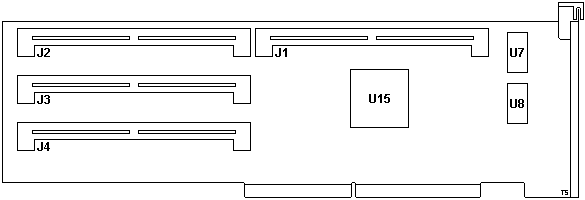
J1-J4 72-pin SIMM socket
U7 75 ns delay
|
U8 150 ns delay
U15 L1A4452 49F5505 gate array
|
The IBM Enh. 80386 Memory Exp. Adapter (FDDF old) totally lacks the resistor
networks between the SIMM sockets. It only has two epoxy coated capacitors on
the left edge (not three).
ECA042 recalls the 49F5507 and replaces it with the 88F0075 -IF- 4 MB SIMMs
are to be used on it. 1 MB and 2 MB SIMMs are unaffected. Uplevel options
34F3011 and 34F3077 which use FRU P/N87F9916, replace option 34F2811 which used
FRU P/N 34F2825. This is done as a precautionary measure due to the possibility
of undetected data modification with 4 MB SIMM(s) installed on this adapter.
FDDF (old, patched) Enhanced 80386 0-14MB Memory Adapter/A
FRU P/N 87F9916, P/N 34F3011, PCB P/N 34F3053
![Front [P]](/other/img/photo.gif)
Jelte's board had J1 and J2 filled with 2 MB 80 ns SIMMs - P/N 65X5806, FRU
P/N 92F0103.
The reworked adapters have pull-down resistors between pins 12 and 19 of the
four 74F657D xceivers (U21-24). Some samples use diagonal through-hole
resistors, other use SMD resistors connected with rework wires. Some boards
have additional bodge wires between U3, U12 & U15 and another wire on the
solder side connected to the delay line U7.
Systems which have the Enhanced 80386 Memory Expansion adapter installed
(FRU P/N 34F2825) may also experience OS/2 TRAP Errors if the Enhanced 80386
Memory Adapter does not have resistors located diagonally across the modules
located in positions U21, U22, U23, and U24. RETAIN RECORD #H037481 should be
referenced for additional details.
H035585 Capacitors May Obstruct SIMM Placement On Adapter
A few Enhanced 80386 Memory Option Adapters may have capacitors obstructing
SIMM placement. SIMMs which are not fully seated can create intermittent
memory failures.
If a capacitor prevents proper SIMM placement in connectors J2, J3 or J4:
J2: Gently bend C3 45 degrees to the right of J2
J3: Gently bend C4 45 degrees to the right of J3
J4: Gently bend C5 45 degrees away from J4
Note:
This applies ONLY to the 80386 Memory Expansion Adapters with capacitors under
the RIGHT end of a SIMM connector. All later versions have relocated the
capacitors from under the RIGHT end of SIMM connectors to the RIGHT of the SIMM
connectors.
FDDF (new) Enhanced 80386 0-14MB Memory Adapter/A 88F0075
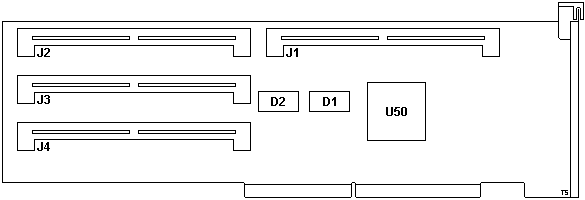
D1 150 ns delay line
D2 75 ns delay line
|
J1-J4 72-pin SIMM socket
U15 L1A4452 49F5505 gate array
|
Same layout as the FDDE adapter below.
Ed. Tom: Does it use the same PCB? Is the U4
EPROM present? Pads only? No pads at all?
The only way you can distinguish the new FDDF from the FDDE is a single
WHITE SIMM socket on the upper right of the FDDF. Looking at Jelte's downlevel
FDDF with all white SIMM sockets, maybe this is why the last FDDF revision had
one white socket, since the original FDDF had black sockets, one uplevel card
had all white sockets, so a way to differentiate the newest version was to have
three black and one white SIMM socket. YMMV...
Note: The FDDF card supports enabling
or disabling Matched Memory.
"Matched Memory Cycles"
"This memory card can disable Matched Memory Cycles for use on
machines which do not have Matched Memory Cycles compatible with the original
16MHz Model-80."
Note: Further meditations on "The Micro
Channel Architecture Handbook" leaves me with the impression that the MMC is
not limited to only the 8580-16MHz, the 8570-Bxx, and the 8573-P75. It says
the system figures out what it can support.
FDDE Enhanced 80386 0-14MB Memory Option 88F0075 / 95F1155
@FDDE.ADF IBM Enh. 80386 Memory Exp. Adapter w/ROM
CFDDE.ADF Init file for @FDDE.ADF
2-14mem.exe Files for 2-14MB 80386 Memory Expansion Adapter
2-14mem.txt
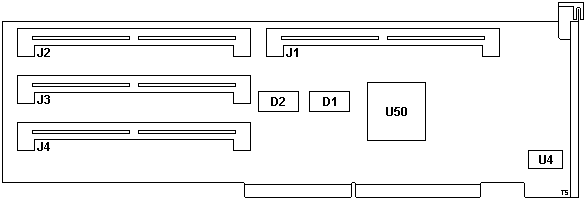
D1 150 ns delay line
D2 75 ns delay line
J1-J4 72-pin SIMM socket
|
U4 HN58C65FP-25T 8Kx8 EEPROM
U50 L1A4452 49F5505 gate array
|
D1 Pulse PE-21785, bel A447-0150-28 72X8359, or compatible 150 ns delay line
D2 Pulse PE-21782, bel A447-0075-62 72X8360, or compatible 75 ns delay line
The IBM Enhanced 80386 Memory Option (FDDE) has the resistor networks
between the SIMM sockets, three epoxy coated capacitors to the left of the
three SIMM sockets, two horizontally aligned delay transformers to the left of
49F5505, an 8K EEPROM (U4) and the upper right SIMM socket is BLACK.
Which makes me wonder which came first. My Pocket Reference says:
| Option # | FRU # | Feature Code | Description |
|---|
| 87F9856 | 87F0075 | 9856 | 4MB Mem Adpt (32 bit, 80 ns) |
| 87F9860 | 87F0075 | 2190 | 4-14MB Mem Adpt (32 bit, 80 ns) |
Look below for the latest Enhanced memory adapter update -
BOPT103.EXE, it will update SC.EXE and the BIOS ROM on your adapter.
Compatible 72-pin SIMMs (by Fred Spencer)
For an explanation of the difference between PS/2 SIMMs and Industry
Standard SIMMs visit the Memory Identification page.
Extensive list of many part numbers for PS/2 SIMMs can be found on the
Memory Reference page.
Below is a short summary of the IBM PS/2 SIMMs that I have found applicable
to PS/2 8580 bus memory adapters.
| Size |
Speed |
Option Numbers |
FRU Number |
Manufacturing (Visible) Number |
| 1 MB |
85 ns |
6450603 |
90X8624 |
65X6264 |
| 2 MB |
85 ns |
6450604, 92G7196 |
92F0104 |
65X6249, 68X6127 |
| 80 ns |
6450608 |
92F0103 |
65X5806 |
| 4 MB |
80 ns |
87F9977, 92G7199 |
92F3337 |
68X6343 |
| 70 ns |
6450128, 92G7200 |
92F0105 |
71F7010 |
If you are looking for an IBM source of Marketing part numbers and FRU part
numbers and other details, visit IBM Memory
Cross-Reference (?) and PS/1 PS/2 PC
Memory Reference.
BOPT103.EXE - Upgrade SC.EXE and ADF/ROM (>16 MB in a 70/80)
bopt103.exe BOPT103 Upgrade (IMA)
Note: Your Reference Diskette MUST be:
- 50/60 version 1.06 or greater
- 55/65 version 1.04 or greater
- 70/80 version 1.10 or greater
- 70-486 version 1.04 or greater
Reference Diskette update is most easily accomplished on a system with two
3.5 floppy drives. If a single drive is used, diskette swapping is required
(may be as high as 55 swaps). In order for the new Enhanced Memory Adapter to
boot up there must be at least 1 MB of "free" memory below the 16 MB limit. If
the sum of system planar memory and any non-Enhanced Memory Adapter system
memory is 16 MB or more, you must move some of that memory to the Enhanced
Memory Adapter (or remove it from your system) in order to use the new Enhanced
Memory adapter.
What does bopt103.exe do?
Peter Wendt woolgathers:
BOPT103 is a workaround to overcome the 16 MB RAM limit on Model
70/80 with the crippled DMA with using 1 x FDDE and 1 x FDDF card. It works -
but it blocks two 32-bit slots... leaving only one single 16-bit slot on
a Model 70 (a more detailed explanation HERE).
In simple words the BOPT workaround asks you to install a maximum of 15 MB
on the planar and the FDDE card leaving a 1MB "addressing gap" for the memory
on the FDDF card. This results in a total of 31MB in the best case. Don't know
if a second FDDF card is also supported, but I don't think so.
The better choice is to forget about the FDDE and FDDF cards and use e.g. a
Kingston KTM-64000 or Acculogic SIMMply RAM 32-bit card that have own memory
mapper and error-detection logic. I have the Acculogic in one of my Model
80-A31 and have a total of 40 MB installed. The KTM should be able to push the
memory up to 64 MB (8 MB on the planar - 3 x 16 MB + 1 x 8 MB on the card) -
but I haven't got the chance to test that. The Acculogic supports only 8 MB
modules.
Updated SC.EXE, Initializers, Active ROM
From WBST:
It should be noted, however, that the improvements to the Set
Configuration utility SC.EXE and the related Adapter Description Programs (ADPs
- Cxxxx.ADF) on the Reference Diskette and/or System/Convenience Partition
*largely* removed the need for Track-0 Initializer programs (Ixxxx.ADF) and the
temporarily active adapter ROM of the Enhanced x-14 MB 80386 Memory Expansion
Adapter with ROM, *provided* properly designed and implemented Adapter
Description Programs (Cxxxx.ADF) were added too.
It was with particular regard to the need to a) prioritize Track-0
Initializers (because of the Intel Above Boards) and b) provide an update to
SC.EXE to cater for the new keywords and their parameters and also a new ADP
multiple invocation call type and entry and return parameter list structure, to
facilitate successful memory expansion additions without the need for POST ROMs
or Track-0 (pre-boot, similar in a small way to Intel's later PXE)
Initialisers, as well as optimise ROM space allocations to enable EMS mapper
window(s) and/or UMBs.
A further benefit of the redesign of SC.EXE and its ADP calling mechanism
was to optimize the *required* adapter ROM address allocations to maximize the
size and potentially reduce the number of free memory blocks within the adapter
ROM space.
These improvements were first distributed via the bootable BOPT103.EXE
Option/Update Diskette (which could require an inordinate number of diskette
swaps in a single floppy drive system) and later via the bootable XGA-2
Adapter/A Option Diskette with a much improved update process involving a RAM
disk.
WBST adds:
Regarding Track-0 Initialisers (Ixxxx.ADF), I *should* have said
that the updated SC.EXE V2.xx and higher *largely* remove the need for them,
provided an appropriately designed ADP (Cxxxx.ADF) has been provided. I have
*never* seen such an updated Option Diskette (ADF and ADP) for the Intel Above
Board series of memory expansion adapters, plus the AOX and Kingston
MicroMaster and MCMaster may require them, due to their much more complex
on-adapter memory mapper, SIMM sockets and configuration possibilities, coupled
with the ROM2RAM, Split Memory Area and Installed and Usable memory complement
updating and calculations/limits of the various system units and their planars'
capabilities and features.
It was with particular regard to the need to a) prioritise Track-0
Initialisers (because of the Intel Above Boards) and b) provide an update to
SC.EXE to cater for the new keywords and their parameters and also a new ADP
multiple invocation call type and entry and return parameter list structure, to
facilitate successful memory expansion additions without the need for POST ROMs
or Track-0 (pre-boot, similar in a small way to Intel's later PXE)
Initialisers, as well as optimise ROM space allocations to enable EMS mapper
window(s) and/or UMBs.
|